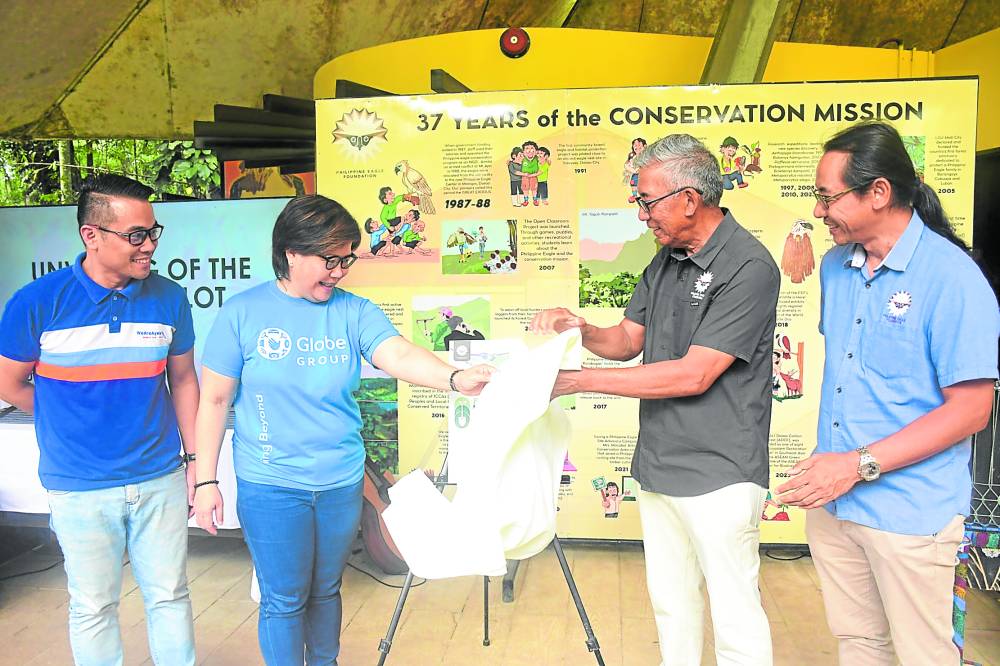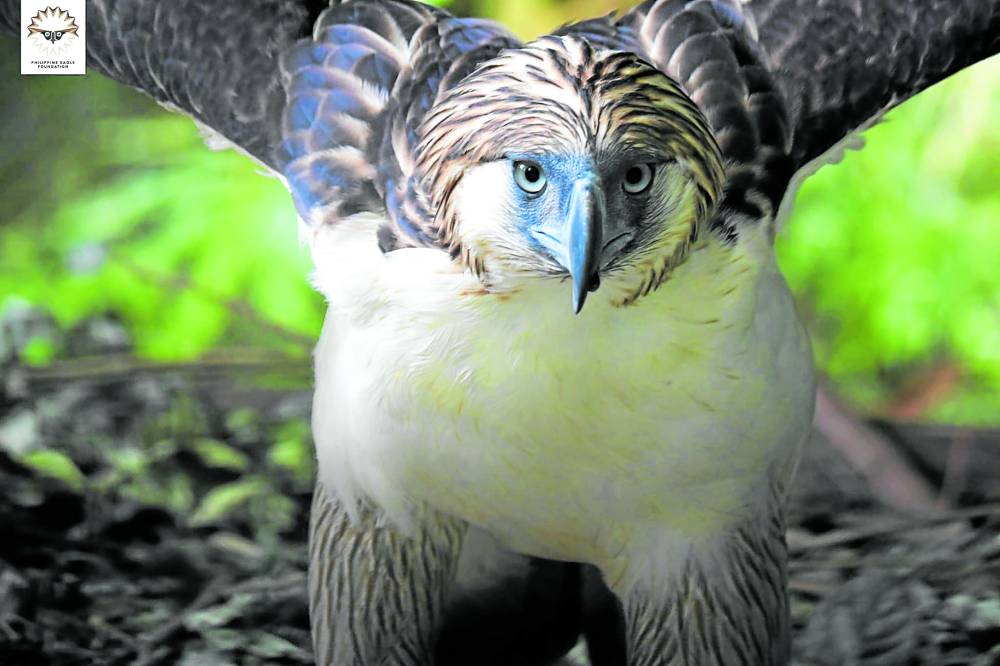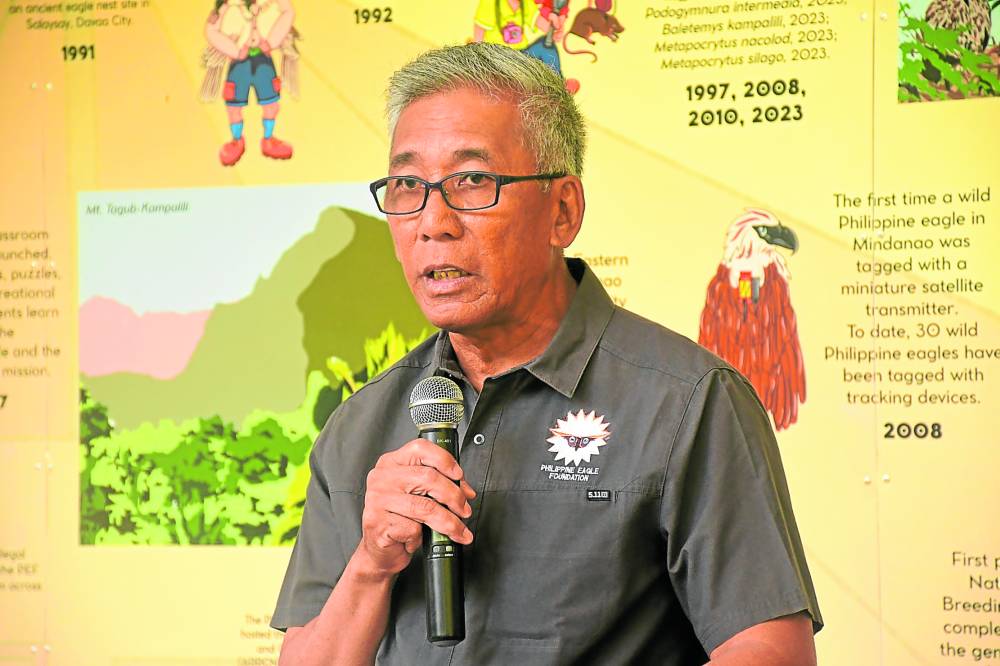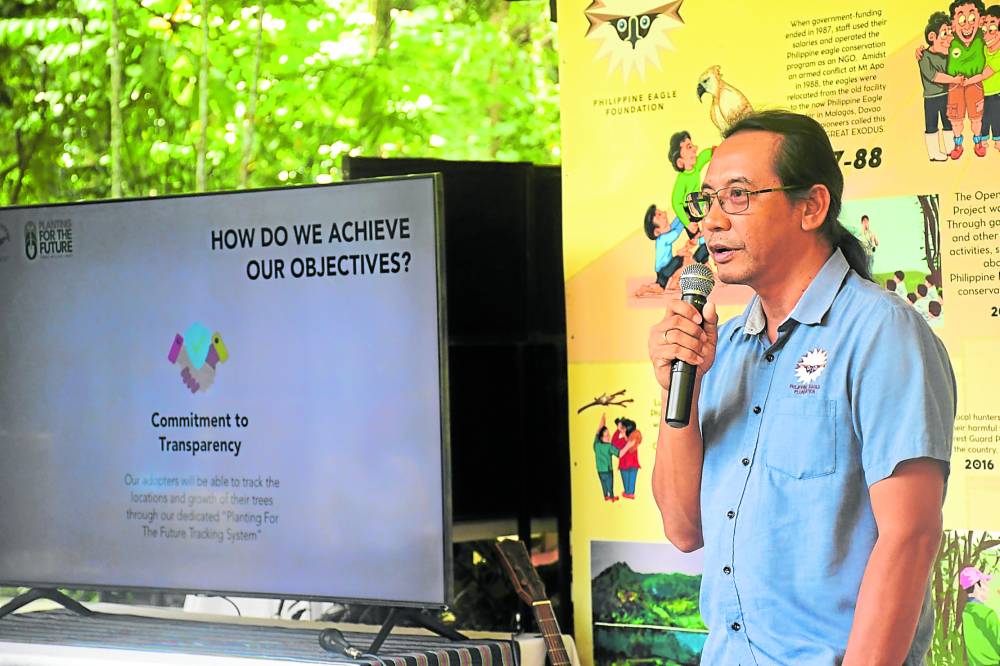Planting for the future of the Philippine eagle

PARTNERSHIP From left: James Lopez, Globe head of Mindanao external affairs, and Liza Reyes, Globe public relations and communications strategy head, with PEF executive director Dennis Salvador and PEF operations director Jayson Ibañez as at the launch of the program to save the Philippine eagle.—CONTRIBUTED PHOTO
In the rainforests of the country, the mighty Philippine eagle (Pithecophaga jefferyi) rules the skies. But its kingdom is shrinking. Deforestation has slashed the habitat of this critically endangered raptor, which soars on wings spanning 7 feet.
Now a bold campaign aims to regreen the eagle’s realm—one seedling at a time.
This bird of prey is the national bird of the Philippines and one of the largest and most endangered eagle species in the world.
It has been classified as “critically endangered” by the International Union for Conservation of Nature since 1990. It is estimated that only about 400 breeding pairs of these eagles remain in their native habitats across the archipelago. The eagle is endemic to the Philippines and found only on four major islands: eastern Luzon, Samar, Leyte, and Mindanao.
The Philippine Eagle Foundation (PEF) has launched an ambitious “Planting for the Future” initiative that aims to plant three million trees, not only providing critical habitat for the critically endangered bird but also addressing broader climate change and sustainability challenges.

ENDANGERED Only around 400 breeding pairs remain in their natural habitat. —Photo from PEF Facebook
The program, done in partnership with Globe Telecom Inc., seeks to rehabilitate 1,200 hectares of degraded land close to nine Philippine eagle nesting sites across four provinces on the southern island of Mindanao: Bukidnon, Cotabato, Davao de Oro and Davao del Sur.
“The ‘Planting for the Future’ program goes beyond simple planting,” says Dennis Salvador, PEF executive director. “PEF will be involved throughout every stage—from propagation and selection of seedlings to maintenance of the mature trees.”
Unlike other reforestation projects that only plant a single species, the initiative focuses on introducing climax native tree species and fruit trees well-suited to the local conditions.
At least 60 varieties are being propagated, including fast-growing pioneer trees that love the sun like antipolo, molave, bayante, anagdong and malibago—as well as slow-growing climax or shade-loving tree species like lawaan, narra ulayan, catmon, kalingag, magkono and others.
“[We’re also] targeting planting native fruit trees in agroforestry sites: durian, rambutan, lanzones, avocado, coffee, cacao, guava, makopa, mabolo, etc.,” Jayson Ibañez, PEF operations director, tells the Inquirer.

Dennis Salvador
Livelihood opportunities
Indigenous communities will also receive additional livelihood opportunities from harvesting the produce of fruit-bearing trees. At least 150 jobs will be created, primarily within the indigenous partner-communities of PEF. They will receive training to conduct nursery operations, plant and monitor the reforested areas.
“[The project] is part of a holistic strategy to support indigenous empowerment and well-being,” Ibañez explains.
The strategy includes training and engaging indigenous people as forest guards as well as supporting artisanal crafts, basic services, and cultural rejuvenation initiatives, alongside facilitating getting formal titles to ancestral lands.
The program also utilizes cutting-edge technology to ensure transparency and precise monitoring. Each nursery seedling receives a unique QR (quick response) code scanned regularly using a web app to update growth data like height and diameter in an online database.
“Through this method, the system updates information on tree growth and characteristics, allowing for precise monitoring of each tree’s development,” says Ibañez. “With this data-driven approach, [we can closely track and evaluate] our reforestation efforts, including measurements of tree height, diameter at breast height, and carbon stock.”
The organization estimates that every young tree planted can capture around 5 kilograms of carbon dioxide per year. As the forests mature, they will act as significant carbon sinks, helping to mitigate climate change.
“What we are doing contributes to the national government’s forest restoration target as outlined in the Philippine Biodiversity Strategy and Action Plan, which, in turn, aligns with the Kunming-Montreal Global Biodiversity Framework,” Salvador notes.

Jayson Ibañez
Holistic approach
The program has incorporated resilience measures against climate threats like droughts, fires, and storms. This includes choosing drought-tolerant species, implementing agroforestry practices to enhance soil health and water retention, and empowering local communities as environmental stewards.
In addition to reforestation, PEF has parallel initiatives to combat other challenges like poaching, illegal logging, and habitat loss from mining. Efforts include strengthening law enforcement, promoting sustainable practices, protecting habitats, and rolling out education campaigns.
In a separate interview with the Inquirer, Globe chief sustainability and corporate communications officer Yoly Crisanto says, “[Our nation] is one of the most vulnerable countries to the impacts of climate change. To mitigate and address the impacts of climate change, a whole-of-nation approach is essential.”
She adds that Globe is enabling customers to support this grassroots effort through mobile apps and platforms. The telco is providing a donation mechanism using its GCash mobile wallet and an option to convert Globe Rewards points into tree adoptions on the GlobeOne app.
As the world grapples with environmental crises, the “Planting for the Future” program is seen to exemplify a holistic approach to conservation.
So much rests on this ambitious planting: fighting extinction, mitigating climate change, lifting communities, reassembling the rainforest pieces into a sustainable whole.
“Every individual has a role to play in conservation,” says Salvador. “Together, we can make a difference and secure a future not just for the Philippine eagle, but all life that depends on healthy forests.”
